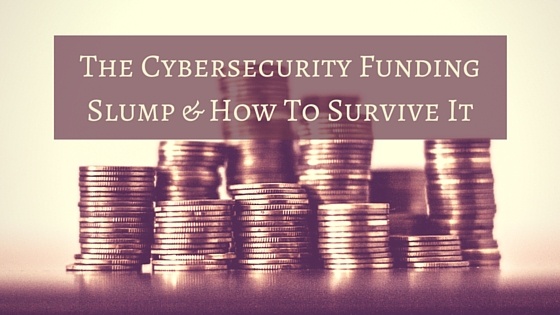
How to Survive The Cybersecurity Funding Slump
Reading time: Just 3 minutes of your time!
There was a massive influx of new cybersecurity startups between 2013 – 2015. Highly publicised hacking incidents and data breaches over the years have cast a spotlight on how vulnerable companies can be to cyber-attacks, leading to a cyber-startup boom. Some startups were immediately valuated in the millions of dollars based on little more than a presentation. According to CB Insights, venture capital and angel investors poured USD$1.7-billion into the cybersecurity market in 2013. In 2014, cybersecurity deals totalled USD$3.8-billion, which showed a 235% growth rate over the past five years.
Big names, including Skype, Ashley Madison, JP Morgan, Adobe and Snapchat, were the victims of data breaches and hacking incidents, and media reports about these incidents continued to fuel the startup market over the next few years. There were already 1500 cybersecurity companies in the market with an estimated 100 new startups per year over the past couple of years alone.
But while the industry took bets on whether there was a bubble and how long before it burst - respectable firms like Imperva, Fireeye and Barracuda were reporting stock losses of over 40% in 2015. Part of the reason for the decline, according to David Cohan, partner at Bessemer Venture Partners, is that, “Too many startups copied technology already on the market, or products that hackers had figured out how to circumvent. Some highly touted products sold by private companies were found to be "obsolete from the moment they were launched," In 2016, VC funding has been reduced to a minimum, and industry veterans agree that this will be a year of acquisitions, mergers and lots of startups closing down, sadly.
Now is the money time
But is it a bubble burst in a crashing cybersecurity industry or a harsh correction? Whichever way you frame it, now is the money time, which should translate into proving that you have a viable product. You need to generate quality leads that turn into a worthy pipeline, in time for your next investor meeting. Here’s how:
- Choose one vertical: Select only one vertical to focus on, one that you know you can provide immediate value to. Financial Services? Healthcare? Tech companies? SMBs? Choose only one!
- Focus your messaging: Make sure your messaging is razor sharp and answers the immediate pain-points of the vertical you have selected.
- Research your competitors: Find out what your competitors are doing and how they are positioning themselves. You can research their weaknesses and use it to sell against them.
- Be authentic: What is your one real differentiator? Or are you a ‘me too’ cybersecurity company? There’s nothing wrong with being a ‘me too’ company because the market is large enough and most products within any given substantial market are ‘me too’.
- Choose the person you want to reach: Do you really need to reach that C-level executive? It’s tempting to think this is the only relevant person in the organisation but this is far from the case. Consider that there might be someone within the security team that could be a really good influencer and target your messages to those people as well.
- Focus your efforts: Choose 2 – 4 marketing activities, don’t try to spread yourself thin by launching 10 different campaigns. This will help you focus on your marketing activities and execute them well. Research what you are going to do, launch your strategies, execute them perfectly and analyse your results so that you can adjust and fine-tune your efforts. For example, include targeted PPC campaigns on Google, Facebook, Twitter or LinkedIn; content and social media campaigns; actively participating at worthwhile events where you invite prospects to network with you and follow up with them afterwards; and PR strategies (but only if you really do have 6 months’ worth of news, interesting announcements and case studies to share).
Marketing Envy provides marketing services for cybersecurity companies that want to differentiate themselves as well as attract and convert new clients. We’ve compiled an ultimate marketing go-to guide that will give you 25 tips, tricks and ideas that have been tested in countless campaigns to create lead generation magic. Download the guide here.






-2.jpg?width=352&name=1%20(2)-2.jpg)